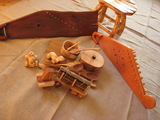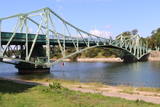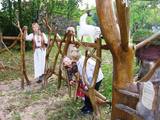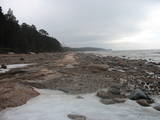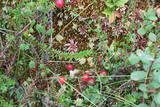| Nr | Name | Beschreibung |
|---|---|---|
|
Um die Tour zu beginnen, steigen Sie in den Zug in Riga und fahren Sie bis zu der Stadt Liepaja, die die Reisenden mit breiten sandigen Stränden und lebhaften Cafés willkommen heißt. Die Tour führt durch Vorstädte von Liepaja und zu der ehemaligen Militärstadt, wo Sie eine orthodoxe Kathedrale, alte Befestigungen an der Küste, die ehemaligen Kasernen und einen eindrucksvollen Militärgefängnis besichtigen, das heute als eine Sehenswürdigkeit angeboten wird. Pavilosta ist eine kleine Stadt an der Küste, die von Windsurfern beliebt ist. Weiter führt die Tour an der malerischen Küste entlang, wo man unterwegs die Steilküste von Jurkalne besichtigen kann, und bis zu der sehr gut gepflegten Stadt Ventspils. Danach geht die Tour zu den Fischerdörfern, die das Zuhause der kleinen finnougrischen ethnischen Gruppe – der Liven – ist. Am Kap von Kolka trifft die Ostsee mit der Rigaer Bucht zusammen. Hier ist es ein Muss, die Vorort geräucherten Fische zu probieren. Weiter auf der Tour können Sie drei unterschiedliche Küstentypen besichtigen: die steinige Küste von Kaltene, die sandige Küste in dem Dorf Upesgriva und die Küstenwiesen in dem Dorf Engure. Die Tour endet mit der Besichtigung der Naturpfade des Nationalparks Kemeri und des Kurortes Jurmala. Danach kehren Sie in Riga zurück. |
||
|
Eine der drei Anhöhen im Südestland mit malerischen Hügeln und schönen Aussichtsplätzen. Im „Zentrum” der Anhöne legt sich der mit Buchten reiche Pühajärv See (Heiliger See). |
||
|
Diese Tour bietet Ihnen die Möglichkeit, das Beste vom Winter in Lettland zu erleben. Sie beginnt in der regen Hauptstadt Riga mit ihrem Weihnachtsmarkt, Verzierungen, Einkaufsmöglichkeiten, vielen Kulturveranstaltungen und Museen, sowie mit der zauberhaften Altstadt. Danach führt die Tour auf dem Land, wo man auf Skipisten und an Schlittenhängen die Winterfreuden genießen kann. Nach einem aktiven Tag ist die Zeit gekommen, sich in einem Spa Hotel verwöhnen zu lassen, wo man auch die gesunden und einzigartigen Rituale der lettischen Sauna ausprobieren kann. Besuchen Sie die Ruinen der mittelalterlichen Burg von Sigulda, die Burg Turaida und probieren Sie den hausgemachten Wein im Landgut von Krimulda. Auf den Naturpfaden des Naturparks Ligatne können Sie sehr leicht die einheimischen wilden Tiere, z.B. Wölfe, Bären, Elche und andere beobachten. Danach können Sie auf einem unweit gelegenen Hof eine Fahrt mit einem Pferdeschlitten genießen. |
||
|
Ein Stegpfad führt zu den Schwefelquellen im Hexenmoor (Raganu purvs), wo sich in Moorseen Sedimente aus Schwefelbakterien und eine besondere Artenvielfalt ausgebildet haben - die so genannten Schwefelteiche. Eine besondere Landschaft und der Duft von schwefeligem Wasserstoff.
|
||
|
The tower is locatede in the Niedrāji-Pilka swamp. Access it via the old Ainaži-Valmiera-Smiltene narrow gauge rail line, which dates back to 1912, and then take the wooden footpaths which are approximately one kilometre long. This is a high-type swamp with small lakes at the foot of the tower. It is in the ZBR. |
||
|
В1699 в центре Нюкши Пасиенские доминиканские монахи построили часовню, на месте которой в 1765 году помещик Хилзен возвел новую церковь. Помещения были маленькие, и в 1922 - 1926 гг. на фундаменте старой церкви строится новая и большая – теперешняя церковь, которую называют одним из самых красивейших деревянных храмов Латгалии. В здании находится центральный алтарь работы второй четверти XVIII века и два боковых алтаря работы примерно 1700 г. Церковь можно осмотреть изнутри. |
||
|
Lēdurgas dendroparks ir viens no bagātākajiem parkiem Latvijā. Parkā var iepazīt vairāk kā 1000 koku un krūmu sugas, pasugas un varietātes. Gadu gaitā Lēdurgas dendroparks kļuvis par dabas un kultūrvēsturisku aizsargājamu objektu. Piedāvājumā - skuju un lapu koki, dekoratīvie un ogu krūmi, vīteņaugi, ziemcietes, tējas augi u.c. |
||
|
Eine der größten befestigten Siedlungen im Bezirk Harju, befindert sich auf einer Erhebung des natürlichen Kliffs Nordestlands. |
||
|
В столярной мастерской в Юркалне мастер Гунтис Ниедолиньш изготавливает деревянные украшения, мебель, предметы интерьера, ложки, лопатки и другие деревянные изделия. |
||
|
The bridge was built in 1906. Part of it was blown up during World War I and later restored. During the Soviet occupation, one needed special permits to cross the bridge. Military ships and other vessels used the canal, because one of the largest military bases in the USSR was sited here. In the summer of 2006, one month before the bridge’s centenary, a Georgian-flagged tanker, the Anna, rammed into the northern support structure of the bridge, and that destroyed the bridge’s turning part beyond recognition. The bridge was renovated and reopened in 2009. You can look at the bridge and cross it at any time.This is a unique engineering monument, and it is the only drawbridge of its kind in the Baltic States. It takes just five minutes to turn the two parts of the bridge.
|
||
|
Семейный парк Лесовницы - расположенное между холмами Кайка объединение хуторов, которое предлагает различные возможности для ознакомления с близким к природе здоровым образом жизни и народной медициной. В рамках предлагаемых хуторами программ можно познакомиться с траволечением, гирудотерапией, волшебным миром пчел и грибов, а также ощутить на себе влияние заклинаний и мест для медитации. Также можно научиться готовить блюда из сорняков, домашний хлеб и лекарство из трав. Одиночные посетители могут самостоятельно познакомиться с хутором. |
||
|
Селга к западу от Туи – важная территория для защиты малой чайки в период весенней миграции. Территория расположена напротив Салацгривского, Лимбажского, Саулкрастского и Царникавского края, ее площадь составляет 58 600 га.
|
||
|
Linezera dabas takā apskatāms ezers, kurš mēdz pazust pazemē. Apmeklējums saskaņojams ar zemes īpašnieku. |
||
|
The ruins of the Rauna castle (which was built in 1262 and was a main residence of the Livonian archbishop) have a modern viewing tower which offers a view of the impressive castle walls, the place where the former Medieval city was located, and the centre of Rauna. The local government office has the keys to the tower.
|
||
|
The territory has been established for protection of the bog and its habitat species. It is not appropriate for visits. North-east part of the bog can be slightly seen from the road Neveja – Lapmezciems on winter season. Further on Cirste direction is located on of most impressive oak trees in Latvia – Rigzemju ozols.
|
||
|
Salos, Vaišnoriškė, Strazdai, Šuminai sind die bewohnten Dörfe im Augštaitija- Nationalpark, in denen historische Einzelgehöfte mit Holzgebäuden erhalten sind. |
||
|
На 141 километре шоссе Риги - Екабпилс можно отдохнуть и покушать в мотеле «Сапнис». На первом этаже – кафе и зал для торжеств. |
||
|
Atrodas uz Imulas upes un celtas 19. gs. sākumā. Uz dzirnavu vārtu staba redzama tēlnieces D. Ezergailes veidota pūce. Pūces dzirnavās savulaik uzņēma pazīstamo latviešu mākslas filmu Likteņdzirnas.
|
||
|
Место, где можно не только переночевать, но и полюбоваться природой и насладиться кухней. Трактир Kogre получил свое название благодаря «супу из семи рыб» ‒ карась (koger) является седьмой по счету рыбой. Хозяин этого заведения ‒ рыбак, и они вдвоем с женой готовят разные блюда из собственноручно пойманной рыбы. |
||
|
Церковь не без основания является одной из самых красивых церквей Курземе. Храм, который являлся родовой собственностью Остен – Сакенов возводился в XVII веке и перестраивался в 1710 году. Созданный деревянный интерьер (рококо с чертами барокко, середина XVIII века) поражает своей красотой и разнообразием. Стоит отметить ложу для господ, хоры органа (1710 г.), сам орган (1856 г.), алтарь, кафедра, скамья для исповеди (середина XVIII века) и др. Роспись потолков относится к 1744 – 1746 гг. и создавалась прусским живописцем И.Ф.Роде. Церковь можно осмотреть изнутри. |
||








